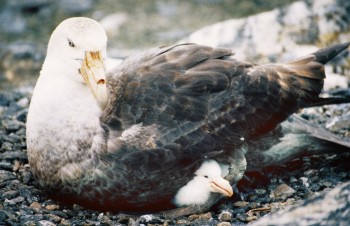Bo-Mi Kim (Unit of Polar Genomics, Korea Polar Research Institute, Incheon, South Korea) and colleagues are publishing in the journal Marine Genomics on a genetic study of the Southern Giant Petrel Macronectes giganteus.
The paper’s abstract follows:
“The southern giant petrel is a large Procellariiform seabird of the southern oceans and has a circumpolar habitat. In this study, we generated the first high-quality de novo assembly of the blood transcriptome of the southern giant petrel (Macronectes giganteus) using the Illumina Miseq platform. A total of 28.7 million raw reads were obtained and assembled using the Oases assembly platform, resulting in 27,989 contigs with an N50 value of 1,044 bp. We performed functional gene annotations using Gene Ontology (GO), Eukaryotic Orthologous Groups (KOG), and Kyoto Encyclopedia of Genes and Genomes pathway analyses. As one of the top consumers in the southern oceans, M. giganteus feeds on carrion and carcasses, unlike most other Procellariiformes. However, geographical isolation is not an absolute defense against parasites or pathogens. We detected many genes that are critically involved in classic innate immunity. In terms of the GO terms analyzed, many genes were assigned to the subcategories of response to stimuli and immune system processes. These numbers were higher than those in the whole blood of lipopolysaccharide (LPS)-injected greenfinches and blood lymphocytes of the Chinese goose but lower than those found in the whole blood of the cinereous vulture. This genomic information will be useful for checking the immune status of southern giant petrels without sacrifice, as the species is vulnerable.”

A Southern Giant Petrel broods its downy chick in Antarctica, photograph by Jeroen Creuwels
Reference:
Bo-Mi Kim, Do-Hwan Ahn, Jeong-Hoon Kim, Jin-Woo Jung, Jae-Sung Rhee & Hyun Park 2018. De novo assembly and annotation of the blood transcriptome of the southern giant petrel Macronectes giganteus from the South Shetland Islands, Antarctica. Marine Genomics doi.org/10.1016/j.margen.2018.05.003.
John Cooper, ACAP Information Officer, 29 May 2018

 English
English  Français
Français  Español
Español